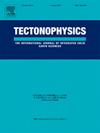Moho depth and sediment thickness estimates for the coastal basins of southeastern Tanzania and the Mozambique Coastal Plain
IF 2.7
3区 地球科学
Q2 GEOCHEMISTRY & GEOPHYSICS
引用次数: 0
Abstract
We investigate crustal structure in the southeastern coastal basins of Tanzania and the Mozambique Coastal Plain (MCP), which formed during the breakup of Gondwana, using P-wave receiver functions and Rayleigh wave dispersion measurements. Sediment thicknesses, Moho depths, and the amount of crustal thinning that occurred during basin formation along the passive margin of eastern Africa are poorly known. Also, for the MCP, the nature of the crust, whether it is stretched continental crust, oceanic crust or transitional crust remains uncertain. Results from 13 seismic stations in the MCP reveal sediment thicknesses ranging from four to nine km and Moho depths ranging from 24 to 37 km, with an average of 28 km. The average crustal shear wave velocities for stations in the MCP range from 3.6 to 3.7 km/s, indicating the crust is of continental origin and not oceanic. In addition, we find little evidence for high velocity mafic layers in the MCP crust, as would be expected for oceanic crust. Assuming a crustal thickness of 37 km for the MCP prior to thinning yields a crustal stretching (β) factor of ∼1.7. Results from six seismic stations in the coastal basins of southeastern Tanzania reveal sediment thicknesses ranging from four to six km and Moho depths ranging from 25 to 34 km, with an average of 30 km. Assuming a crustal thickness of 38 km for southeastern Tanzania prior to thinning yields a crustal stretching (β) factor of ∼1.5. This finding, when combined with the β factor for the MCP, suggests similar amounts of crustal stretching along much of the eastern African passive margin.
坦桑尼亚东南部沿海盆地和莫桑比克沿海平原的莫霍深度和沉积物厚度估计
本文利用p波接收函数和瑞利波频散测量,研究了冈瓦纳破裂期间形成的坦桑尼亚东南部沿海盆地和莫桑比克沿海平原(MCP)的地壳结构。沉积物厚度、莫霍深度以及在东非被动边缘盆地形成期间发生的地壳减薄量,人们知之甚少。此外,对于MCP来说,地壳的性质,是拉伸的大陆地壳、海洋地壳还是过渡地壳,仍然不确定。MCP 13个地震台站的结果显示,沉积物厚度为4 ~ 9 km,莫霍深度为24 ~ 37 km,平均为28 km。MCP台站的平均地壳横波速度在3.6 ~ 3.7 km/s之间,表明地壳为大陆源而非洋源。此外,我们发现MCP地壳中存在高速基性层的证据很少,而海洋地壳中可能存在高速基性层。假设MCP在变薄之前的地壳厚度为37 km,则地壳拉伸(β)因子为~ 1.7。坦桑尼亚东南部沿海盆地的六个地震台站的结果显示,沉积物厚度从4到6公里不等,莫霍深度从25到34公里不等,平均为30公里。假设坦桑尼亚东南部在变薄之前的地壳厚度为38 km,则地壳拉伸(β)因子为~ 1.5。当结合MCP的β因子时,这一发现表明,在东非被动边缘的大部分地区,也有类似数量的地壳拉伸。
本文章由计算机程序翻译,如有差异,请以英文原文为准。
求助全文
约1分钟内获得全文
求助全文
来源期刊

Tectonophysics
地学-地球化学与地球物理
CiteScore
4.90
自引率
6.90%
发文量
300
审稿时长
6 months
期刊介绍:
The prime focus of Tectonophysics will be high-impact original research and reviews in the fields of kinematics, structure, composition, and dynamics of the solid arth at all scales. Tectonophysics particularly encourages submission of papers based on the integration of a multitude of geophysical, geological, geochemical, geodynamic, and geotectonic methods
 求助内容:
求助内容: 应助结果提醒方式:
应助结果提醒方式:


